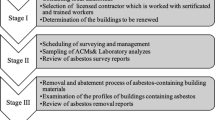Abstract
Many construction products contain asbestos. These are incorporated in the buildings in which we live. The term “asbestos” refers to six fibrous silicate materials that are naturally found in the Earth’s crust. It consists of many tiny fibers that can be seen only with a microscope. When products containing asbestos are disturbed, the asbestos fibers are broken into smaller pieces and these pieces float into the air even under the smallest air currents. Friable materials are therefore to be removed from buildings before demolition since they are considered hazardous waste, whereas non-friable materials may be normally treated as construction debris.
Since asbestos represents material that is used in constructing floors, partition walls, thermal isolation, water and sewerage pipes, i.e., it represents part of the buildings, it is exposed to earthquake effect, as well.
The present paper deals with the effect of earthquakes on asbestos plates and how this reflects the health of the population. Protection against these effects and regulations to be observed are also presented.
Similar content being viewed by others
References
Arsovski M, Petkovski R 1975: Neotectonics of Republic Macedonia. IZIIS49, Skopje
ATSDR (Agency for Toxic Substances and Disease Registry) 1997: Asbestos Toxicity, Case Studies in Environmental Medicine. US Department of Health and Human Services, Atlanta
Camus M, Siemiatycki J, Meek B 1998: Nonoccupational Exposure to Chrysotile Asbestos and the Risk of Lung Cancer. International Programme on Chemical Safety (IPCS), Vol. 338.
CHAPD (Chemical Hazards and Poisons Division) 1995: Toxicity summary for asbestos. Prepared by S Bull, Chemical Hazard Evaluation and Biomedical and Environmental Information Analysis Section, Health and Safety Research Division, Risk Assessment Information System (RAIS)
Iarc L 1983: Summary of Data Reported and Evaluation. IARC Monographs on the Evaluation of Carcinogenic Risks to Humans, International Agency for the Research on Cancer, Journal Biologia Plantarum, Lyon
John S 2008: Actinolite, Amosite, Anthophyllite, Chrysolite, Crocidolite, Tremolite. Monographs on the Evaluation of Carcinogenic Risks to Humans LARC, International Agency for the Research on Cancer, Lyon, Vol. 42.
Pitt R 1986: Asbestos and Other Natural Mineral Fibres. International Programme on Environmental Health Criteria 53. WHO, Geneva
Toft P, Fawell J K, Lund U, Mintz B 1984: Asbestos in Drinking-Water. Department of National Health, Ontario, Canada
Author information
Authors and Affiliations
Corresponding author
Rights and permissions
About this article
Cite this article
Dimiskovska, B. Environmental risks due to debris containing asbestos in post-earthquake conditions. Acta Geod. Geoph. Hung 45, 299–306 (2010). https://doi.org/10.1556/AGeod.45.2010.3.4
Published:
Issue Date:
DOI: https://doi.org/10.1556/AGeod.45.2010.3.4




